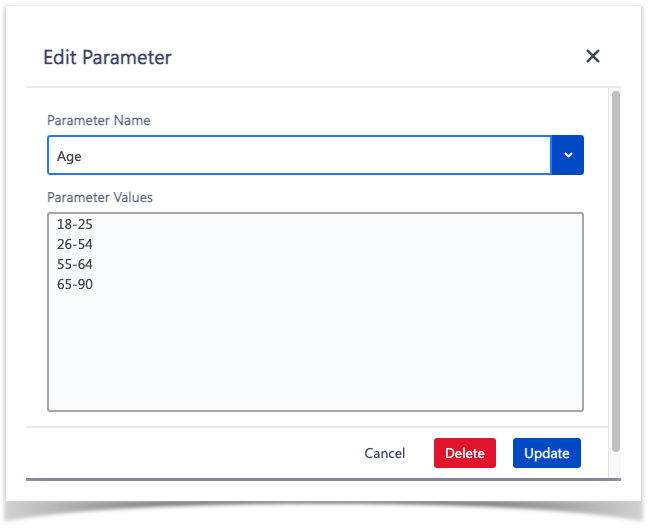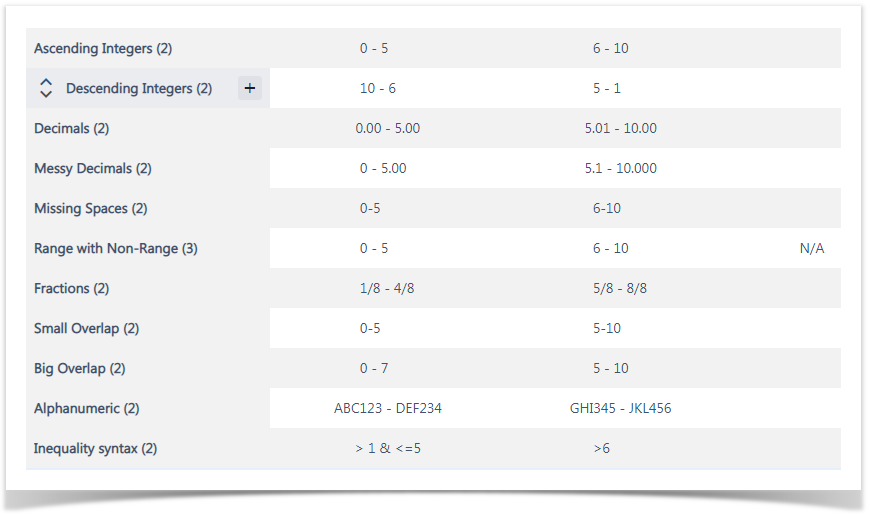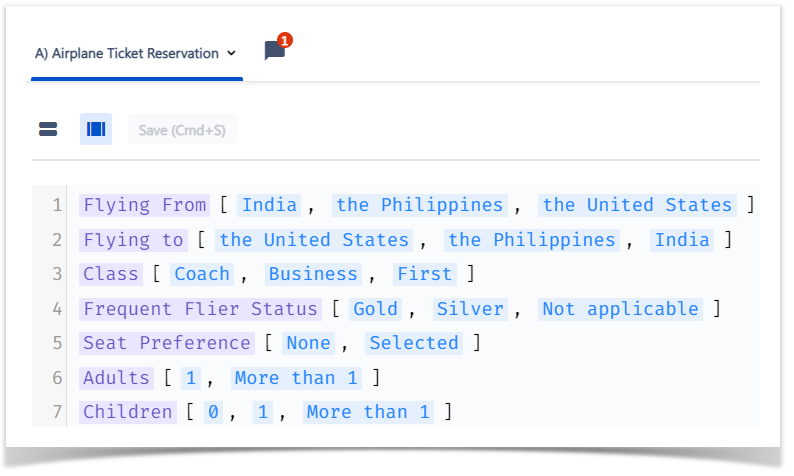Page History
Table of Contents
Overview
Parameters are the factors to be tested in Test Case Designer scenarios. For example, "Browser Type", "Payment Method", "Age", etc.
When creating your Test Model, you need to define which parameters should be consider and their values.
Parameter values are the different ways that a parameter can vary - these are the values that are chosen in a given test case for a given parameter. For example, examples of parameter values might be "Browser Type" of “Google Chrome”; "IE"; "Safari".
Deciding what to include as parameters and values in your Test Model will be the most important part of the entire test design process.
Create a Parameter
< Explain how to create a parameter>
| Tip | ||
|---|---|---|
| ||
In some situations, descriptive fields are not the best and more practical way to use parameters in your model. In the example, you can see the parameter "Age" with a descriptive value. Instead of descriptions, maybe you could use the numbers for the ones you want tested. In the example, you can see the same parameter "Age" but now with numerical value. |
Create a Parameter with a Ranged Value - Boundary Testing
Instead of using descriptive or numerical values, you may use range values.
Range values are useful when there is required to test around cutoffs for certain businesses rules, that adds too many values to your parameters and it's not efficient.
To create a range value, use the syntax ‘number space hyphen space number’ (i.e., # – #), Xray Test Case Designer will recognize it as a range of values to choose from.
Bellow, check the example with the Parameter "Age":
Additionally, will handle a ranged value as a set of numbers inclusive of your endpoints. Therefore, Xray Test Case Designer will in effect boundary test the range and then randomly choose numbers from within that range (as it needs for tests).
See below how the ranged values above turn into values to use in your tests.
Xray Test Case Designer can recognize many options for ranges. We recommend having the same number of decimals across all numbers in a range. Additionally, all ranged values must not overlap. The tool will not recognize logic like in alphanumeric codes either.
| Info |
|---|
See below for an example of ranges as inputs followed by the outputs provided. |
Create a New Value Expansion
If your model includes a long list of values, you are in danger of generating way more tests than needed. The Value Expansions feature can dramatically reduce the number of tests generated in these situations. By maximizing variation and minimizing repetition, the Value Expansions feature helps testers cover as much as possible in as few test cases as possible.
| UI Steps | ||||||
|---|---|---|---|---|---|---|
| ||||||
|
Using the Value Expansions feature has powerful advantages over the other options. Compared to using 45 individual Values, this approach has 144 fewer tests to execute. And compared to using just the 9 categories of vehicles as your Values, the test cases generated with the Value Expansions feature are:
- more specific,
- more varied, and
- achieve more coverage.
| Note | ||
|---|---|---|
| ||
Expansions are a great way to get additional variation in your tests without sacrificing the number of tests. But not all value expansions are guaranteed to be included in your tests. For example, consider 10 value expansions for 1 value in a model that generates a set of 20 tests. The value in question may only show up a few times of that 20, maybe 5 times. Therefore, only half of the value expansions will be covered. |
View Parameter
Standard View
< Explain Standard View >
Bulk View
<Explain Bulk View>
Edit a Parameter & Values
<Explain how you can edit a parameter and values>
Bulk Edit Parameters
Parameters bulk edit enable a faster way to make changes to several parameters' values quicker and in a more efficient way.
| UI Steps | ||||
|---|---|---|---|---|
| ||||
|
| Info |
|---|
Changing the name of a parameter or value in Bulk Edit mode would cause Xray Test Case Designer to recognize the edited parameter or value as a completely new entry – triggering a message warning you about the potential loss of constraints/requirements/value expansions. Typing in new parameter names through Bulk Edit won’t give you access to the auto-suggested list of already-created reusable parameters that you see when adding parameters through the standard Edit mode. You also can’t create value expansions from the Bulk Edit window. |
Delete a Parameter
<Explain how to delete a parameter>
Reorder a Parameter
< Explain how you can move up or down a parameter, mention the possibility to move using bulk edit>This section covers the basics of managing your key model elements located on the "Parameters" screen.












